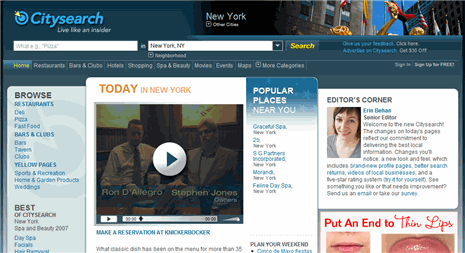Today, IAC’s Citysearch becomes the first major local search consumer destination to add video on any kind of scale (note the qualifiers). In addition to video, produced by TurnHere and currently available on the New York, San Francisco and Los Angeles sites, the press release explains other changes and upgrades.
The major change, outside of video, is a new “look and feel” that is comprehensive: more images, new profile pages, less cluttered search results pages, improved navigation and browsing. There’s also more personalization in the form of suggestions based on past search behavior.

While Citysearch was an early pioneer in local search it had become like the Chrysler minivan, the inventor of the genre that has now been surpassed by Japanese rivals. The old site was “cold” and cluttered with too many ads. The new site is graphically richer and highlights editors in each city (with pictures) to literally put a human face on the site. The local video also helps do the same thing.
(The question now is whether Citysearch can regain some momentum lost in specific markets to sites like Yelp or Yahoo! Local, to greater local competition generally and to and to the larger Internet phenomenon of search engine usage.)
The beauty of video for Citysearch is that it should have little trouble selling the ads, which are part of a package if you spend more than $800 per month, and production is totally outsourced to TurnHere (I suspect a probable IAC acquisition target at this point.) I have long been a fan of TurnHere and the work the company does, which is advertising but doesn’t feel that way. (The commonly used term is “advertorial.”)
For a limited window of time Citysearch will be the only local search destination with its degree of visibility to have video. If I were sitting at the swanky new Frank Gehry-designed IAC headquarters in New York, I would be planning to spend some consumer marketing dollars (online and off) promoting the new site before video becomes all but ubiquitous. It’s not clear the company will do that however.
Another restaurant site that beat Citysearch to the local video punch, but isn’t very well known, is Savory New York; there’s also Savory San Francisco and Savory Chicago.
Dex has had video ads for some time (but they’re not very prominent) and MojoPages introduced user-generated video (but it’s only in one market). There are also various travel sites that now have local video.
But this is the “shot across the bow” for other local search sites. Everyone will sooner or later have to confront the issue of video and make a conscious choice to add or eschew it. If the decision is in favor of adoption, the question becomes how to get it. (Here’s my related post from early this year Local Video: Who Will Shoot It?) And quality matters (notwithstanding the early popularity of poor quality videos on YouTube).
One question in my mind about Citysearch’s future had been: what is its “going forward” relationship with Ask City? Citysearch appeared to be turning into something of a sales channel and marketing agency for local businesses and less and less of a consumer destination. Here’s what I said in my related Search Engine Land post about the issue of the relationship between Citysearch and Ask City:
Citysearch provides a substantial amount of the content for Ask City, also owned by IAC. One of the questions after the launch of AskCity had been: what is the relationship of the two brands? The changes and updates make a much stronger case for the independent existence of Citysearch and suggest how the two destinations might co-exist — their user experiences are more differentiated now (especially with the addition of video).
–
Greg Sterling is the founding principal of Sterling Market Intelligence, a consulting and research firm focused on online consumer and advertiser behavior and the relationship between the Internet and traditional media, with an emphasis on the local marketplace.


